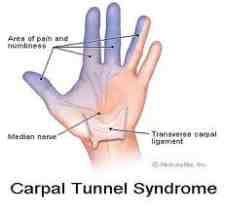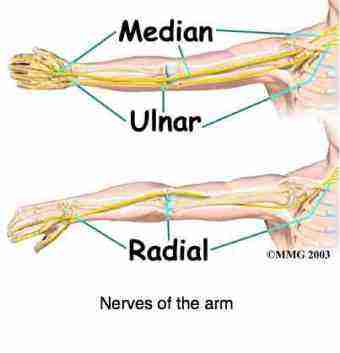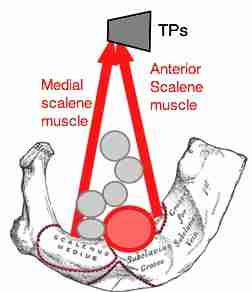Upper limb tension test
Upper limb tension test is in the examination of arm pain; is it caused by a pinched nerve? A slipped disc in neck is one of the most painful conditions treated by your chiropractor.
At the Chiropractic Coalface it's very useful to have quick, inexpensive and simple tests for pinched and irritated nerves.
- For the lower limb, the Slump Test for Sciatica pain fits the bill, though the Femoral nerve is far more difficult to test.
- In the upper limb? Yes, the ULTT.
- Spurling's test confirms it.
There are three main nerves supplying the arm:
1. The Median nerve

This page is by the way not an exhaustive discussion of these structures. It's highly involved neuroanatomy. If you want more specific details, google median nerve and choose the Wikipedia link.
The median is one of three large nerves that supply the arm.
The median nerve passes from the lower neck, forms a part of the brachial plexus and emerges from the chest cavity through a narrow gap called the inter scalene triangle.
From there it passes through the thoracic outlet, rounds the pectoralis minor tendon, through the armpit and down the front of the arm supplying inter alia
- the palmar surface of three and half fingers.
- muscles in the front, anterior, part of the forearm.
- muscles of the thumb.
- muscles that flex and extend the fingers; the lumbricals.
If the nerve is tethered somewhere along this tortuous course, sometimes in two places, one of which is in the carpal tunnel, a so called double crush syndrome occurs; then it classically causes tingling and numbness in the fingers, always excluding the pinkie you'll note from the graphic below.

Extending the elbow and wrist, two key components of the upper limb tension test, puts the median nerve under tension.
Rotating the head and neck to the opposite side puts the nerve under increasing stretch.
Rotating the head to the same side may produce pain and tingling in the arm. There'll be more about Spurling's test lower down.
The beauty of these tests is that you can do them easily at home, though interpreting the results is not straight forward, and be careful; they can actually provoke the condition. That's the purpose of an orthopedic test, enabling the examiner to determine what tissue is likely to be causing the pain and tingling in the arms and hands.
If the entrapment is in the inter scalene triangle then raising the arm above the head usually increases the tingling.
Conversely, raising the arm brings relief if there's an entrapment in the inter vertebral foramen by a disc or degenerative uncovertebral joints of Luschka.
If you're not squeamish, see what a large snake can do to the arm, exposing the muscles supplied by the median nerve.
2. Radial nerve
The radial nerve also passes from the lower cervical spine through the inter scalene triangle, the brachial plexus but passes down the back of the upper and lower arm, and momentarily the front of the elbow.
Hence this version of the upper limb tension test is much less effective in testing for a lesion of the radial nerve.
The radial nerve is:
- sensory to the back of the arm and forearm and back of the hand and most fingers
- motor to the muscles of the back of the arm (triceps) and forearm (extensors of the wrist)
For specific details, it's complex, see wikipedia.
It's intimately involved in tennis elbow and some of the rotator cuff syndromes of the shoulder when the triceps becomes extremely painful.
One important piece of information: in serious cervical spine injuries, the triceps muscle is the most common weak muscle, medically known as paresis. The muscles of the triceps waste and extending the elbow becomes weak.
For example, recently a builder with a slipped disc in neck said he had difficulty lifting himself in to the ceiling, by pressing down on the trapdoor.

3. Ulnar nerve
Again the ulnar nerve passes from the lower nerve roots of the neck (not C5-C6) C7-C8-T1 in the lower neck, combining and twisting in the brachial plexus, again passing through the interscalene triangle, together with the subclavian artery. They then pass behind the collar bone via the "thoracic outlet", a space bounded by the first rib, clavicle, and the upper lung.
An entrapment in this space is called a thoracic outlet syndrome which is often involved in the shoulder and arm pain syndromes like frozen shoulder; tingling in arms and hands, particularly the pinkie side of the lower arm is common.

It's the ulnar nerve that passes down the back of the "humerous" bone, forming the "funny bone" - actually the ulnar nerve in the inner elbow - before passing down the forearm to the pinkie side of the hand.
It supplies:
- the skin of the pinkie and half the ring finger and adjacent hand
- the muscles mainly of the pinkie, and one muscle of the thumb
- the flexor muscles in the forearm that flex the wrist and fingers
Tingling in arms and hands
Tingling in arms and hands can be affected by all these nerves but following very different patterns, helping your chiropractor decide where your problem is mostly likely located. The upper limb tension test is just one tool in his or her hand enabling him or her to come to the correct diagnosis.
Upper limb tension test
Upper Limb Tension Test is beautiful in its simplicity. So simple in fact that you can do it at home to test if you have a pinched nerve in the neck; It's confirmed by Spurling's sign; see lower down.
Whilst there are variants of the test to investigate tension in the different nerves, research suggests that only the Median nerve ULTT is sensitive and specific. Upper limb tension test research by Kleinrensink et al.
Position
You can do this test on your own, but a helper is useful. This for the right arm; test first with your non symptomatic arm to establish the normal pull in the arm.
Lie flat on your back with arms and head in the neutral position.
- First move the normal arm out to the side, just above 90 degrees
- The helper kneels at your head using his her left hand under your right shoulder blade, depressing it towards the hip
- palm up,
- straighten the elbow and
- extend the wrist. Remember what you feel, particularly in the lower arm.
- Repeat with the naughty arm.
- If you are unable to move the arm out to the side because of shoulder pathology, then the test cannot be done satisfactorily.
So, what constitutes a positive test?
If the naughty limb, particularly the lower arm, is much tighter, tingly, or painful, then it's considered positive for an irritated or trapped nerve. A slipped disc in neck must be considered.
It is often accompanied by a positive Spurling's test. Turning your head to the side of the painful arm, and then simultaneously looking up will produce pain in the neck and or arm. Take care to do this test gently as it certainly can aggravate the condition.
Do coughing and sneezing hurt?
Because the median nerve is supplied by all five rootlets from C5 to T1, a lesion at any of these levels is likely to cause a positive test.
Slipped disc in neck
Slipped disc in neck is one of the most painful conditions faced at the chiropractic clinic. The ache in the arm, especially at night is often dreadful. The upper limb tension test helps confirm the diagnosis.
That could be from the disc, or from the tissues around the intervertebral foramen, notably degenerative facet joints or old injury to the uncovertebral joints of Luschka. More lower down.
Chiropractic
help is a very large site. By using the search function in the
navigation bar you'll more in depth information about for example the
uncovertebral joints or carpal tunnel syndrome, or the inter scalene
triangle for example.
UPPER LIMB TENSION TEST +
Upper limb tension test + puts more stress on the nerve.
Repeat the above test, but then also laterally flex and rotate the head to the opposite side. This further puts the Median nerve under even greater tension.
Is the lower arm now tingling, tight or painful?
Spurling's sign
Spurling's sign often confirms slipped disc in neck; if the upper limb tension test is also positive.
If looking up, and turning your head to the same side causes pain or tingling down your arm then you have a positive Spurling's test.
Keyboard use
In a very interesting study on computer users complaining of arm pain what was in fact diagnosed as repetitive strain injury, manual therapy, volume 2, aug 1997, every single patient had a positive upper limb tension test. The authors concluded that a repetitive strain injury in conjunction with mouse and keyboard use was in fact neurogenic in origin.
Interestingly, computer workers without pain had a higher incidence of a mildly positive upper limb tensions test than non computers users. They described these computer users as in a sub clinical pathological state. There was a great likelihood that they would develop pain in the future.
Here's one small but important tip for folk who spend long hours at the computer; use a support such as a small table under the elbow of the mouse arm to prevent this debilitating ache so often associated with using a computer. Especially should you have a positive upper limb tension test.
To distinguish between a thoracic outlet syndrome and a nerve root entrapment in the neck, your chiropractor will do Adson's test. This examines the arterial pulse in the wrist whilst moving the head and breathing in. Remember, the artery passes together with the nerves through the inter scalene triangle.
To complicate matters further, the nerve artery bundle can be tethered by the pectoralis minor tendon.
This is a difficult test, though; it took me several years to perfect its use to my satisfaction. One gets a lot of false positives, folk with a seemingly positive test but no symptoms. I've changed the position of the arm from the classical test, to eliminate this confusing anomaly. There's no point trying it yourself, it's highly sensitive, and even your doctor will be clueless unless he uses it regularly.
Again, unlike the upper limb tension test, and Spurling's test, Adson's test is not for the layperson to attempt.
The UncoVertebral joint = Joint of Luschka
This tiny joint in the lower neck is often the spoke in the wheel in many neck-arm-pain cases. The little uncus is very susceptible to injury in whiplash, becoming arthritic and affecting the nerve root as it emerges from the spine. Read more at UncoVertebral Joint Luschka.
Useful links
Arm pain snake bite
Just a reminder that there are many causes of arm pain. From fractures, to sprains, cancer albeit rare, to snake bites. Arm pain snake bite; shocking damage to his arm. Upper limb tension test may appear positive in all of them but the history and other tests rule it out.

When browsing these links use right click and "Open Link in New Tab", or you may get a bad gateway signal.
Did you find this page useful? Then perhaps forward it to a suffering friend. Better still, Tweet or Face Book it.
